A deadline is closing in, the parts need to be made, and you’re stuck between two choices: CNC milling or laser cutting. Both can deliver results, but the wrong pick could mean wasted money, delays, or parts that don’t meet requirements.
This happens more often than you’d think. Too many people assume CNC milling and laser cutting are basically the same. They’re not. Each one shines in very different scenarios, and if you don’t know which fits your project, you risk setbacks you can’t afford.
The good news is you don’t need weeks of research to figure it out. This guide lays everything out in plain language so you can decide with confidence. By the end, you’ll know the strengths, drawbacks, and best uses for each process.
Also Read: Laser Cutting vs. Waterjet vs. Plasma: Which Is Best for Your Material?
Table of Contents
What is CNC Milling?
CNC milling is a process where a machine cuts away material from a solid block to create the final part. The machine follows computer instructions while rotating cutting tools shape the piece with accuracy.
It works like carving with power tools but on a much more precise level. The big advantage is consistency since the machine can repeat the same cut over and over without losing quality. Because it can handle depth, grooves, and detailed 3D shapes, it’s widely used in industries like aerospace and automotive.
Common Materials and Applications
CNC milling is versatile and works with a wide range of materials. Some of the most common include:
- Metals: aluminum, steel, titanium
- Plastics and composites
Typical applications are found in:
- Aerospace brackets and turbine components
- Automotive molds and gears
- Tooling and fixtures for production lines
This adaptability is why many shops consider CNC milling the backbone of their operations.
What is Laser Cutting?
Laser cutting doesn’t use blades or drills. Instead, it directs a focused beam of light that burns, melts, or vaporizes material along a programmed path. Different types of lasers exist, such as CO₂ lasers, fiber lasers, and Nd:YAG lasers. Each has its specialty, but they all share one thing: precision without physical contact.
According to Grand View Research, the global laser cutting market is projected to pass $8 billion by 2030, which says a lot about how fast industries are adopting it.
Common Materials and Applications
Laser cutting is especially good with thin and delicate materials. It handles:
- Metals like stainless steel and aluminum
- Plastics and composites
- Glass and ceramics
- Fabrics and organic materials
Industries use it for:
- Sheet metal fabrication
- Electronics manufacturing
- Medical devices
- Custom signage and decorative projects
Because there’s no tool physically touching the workpiece, tool wear isn’t an issue, which means consistently clean results.
Key Differences Between CNC Milling and Laser Cutting
To really understand which one is best, let’s break down the major differences.
Process Type
CNC milling is mechanical. It removes material with a cutting tool. Laser cutting is thermal. It slices through material with heat from a laser beam.
Material Thickness and Flexibility
Milling thrives on thicker, stronger materials. Laser cutting handles thin sheets or intricate patterns much better. If you need to carve a block of steel two inches thick, go with milling. If you’re making detailed cuts in a stainless steel plate, laser cutting is the clear winner.
Precision and Accuracy
Milling delivers tolerances around ±0.001 inch. Laser cutting can reach as tight as ±0.0005 inch, depending on the setup and material. For flat, detailed work, lasers usually edge ahead.
Speed and Output
Lasers cut thin sheets much faster. Milling takes more time to set up and run, but it handles complex 3D parts better than lasers ever could.
Pros and Cons of CNC Milling
Before diving into the details, it’s important to understand where CNC milling excels and where it falls short.
Advantages
- Handles thick, tough materials
- Excellent for 3D shapes and complex parts
- High repeatability and accuracy
- Proven track record across multiple industries
Disadvantages
- Creates more material waste
- Cutting tools wear out and need replacement
- Slower for high-volume production compared to lasers
Also Read: Complete Guide to Laser Solutions for the Industrial Sector
Pros and Cons of Laser Cutting
Laser cutting brings a very different set of strengths and limitations compared to milling.
Advantages
- Extremely fast for thin sheets
- Produces intricate and decorative designs
- No direct contact, so no tool wear
- Can cut and engrave in one process
Disadvantages
- Less effective with very thick metals
- Higher energy consumption
- Risk of thermal distortion or discoloration if not calibrated properly
Cost Considerations
Instead of worrying about the heavy investment of purchasing and maintaining a machine, many businesses find it more practical to work with a professional laser services company. This way, you avoid the upfront expense of high-end optics, cooling systems, or specialized tooling that milling and laser machines demand.
Operating Costs
When you outsource, you also skip the ongoing costs of energy consumption, tool replacements, and maintenance. For example, lasers are known to consume more energy per hour compared to milling machines, while milling racks up recurring tool expenses. By working with a laser services provider, those operating costs stay off your balance sheet.
Scalability and ROI
Partnering with a laser cutting service company allows you to scale projects easily. Large runs of thin sheet parts are handled quickly and cost-effectively with laser cutting, while smaller or more complex jobs can still be managed without you needing to buy additional equipment. This flexibility means you can achieve a higher return on investment without the financial risks tied to machine ownership.
When to Choose CNC Milling
CNC milling is the right pick for:
- Thick metals and strong materials
- Complex 3D designs
- Applications requiring durability
Industries like aerospace and automotive depend on it for structural parts that need to perform under stress.
When to Choose Laser Cutting
Laser cutting shines when:
- You need thin sheets cut quickly
- The design involves detailed or decorative patterns
- Production runs are large
Electronics and medical industries rely on laser cutting for speed and precision at scale.
CNC Milling vs. Laser Cutting: Quick Comparison
To make choosing the right method easier, here’s a side-by-side comparison of CNC milling and laser cutting across key factors like precision, speed, materials, and cost.
| Factor | CNC Milling | Laser Cutting |
| Process Type | Mechanical (subtractive) | Thermal (laser beam) |
| Precision | ±0.001 inch | ±0.0005 inch |
| Best Materials | Metals, plastics, composites | Metals, plastics, glass, ceramics |
| Speed | Slower, depends on tooling | Faster on thin sheets |
| Costs | Higher tooling & setup | Higher energy usage |
| Applications | Aerospace, automotive, molds | Electronics, signage, medical |
FAQs
Which is cheaper: CNC milling or laser cutting?
Milling is often cheaper for thicker parts or small production runs. Laser cutting tends to be more cost-effective for large runs of thin sheet metal.
Can laser cutting fully replace CNC milling?
No. Milling handles thicker materials and complex 3D parts that lasers can’t cut. Both have unique roles.
Which is better for prototypes?
Laser cutting is faster for quick prototypes in flat materials. Milling is better when prototypes need structural strength or 3D details.
Do tolerances differ a lot in real-world use?
Both deliver high accuracy. Lasers can hit finer tolerances for flat work, while milling holds precision across complex geometries.
Which one is more eco-friendly?
Laser cutting creates less scrap but consumes more energy. Milling makes more chips, but those materials can usually be recycled.
Conclusion
CNC milling and laser cutting each bring unique strengths to the table. CNC Milling is the go-to when you need durability and complex 3D shapes, while laser cutting shines for thin materials and detailed designs. At the end of the day, the best choice comes down to your material, project needs, and production goals.
At Rache Corp, we’ve been helping companies make that choice for over 30 years. Our custom laser systems handle projects most shops can’t, and our team knows how to cut cycle times, lower material waste, and boost overall output. If you want to get the most out of your next build, give us a call at (805) 389-6868.

